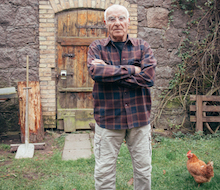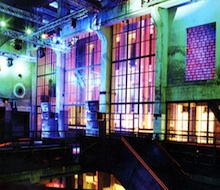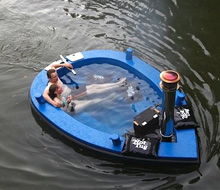For our Fashion Debrief, we spoke to Loomia Founder Madison Maxey about how future fashion will have inbuilt smart textiles that help you live a more fulfilling life
In the past, the most we would expect from our clothing was that it would keep us from being naked and look interesting. Nowadays, thanks to the advent of biometric data and smart fabrics, we don’t just look to clothing as a ‘product’ to throw on and stop us from getting frostbite in the winter, but rather to help add true value to our everyday life. Enter the products as services phenomenon. If we expect our $700 iPhone to wake us up, alert us of a change in weather, track our health and keep us connected to the world around us, then why wouldn’t we expect the same from our $700 leather jacket?
Often when people think of wearable tech, they often think of the “a computer just threw up on me look” and question the need for a smart blazer if they already have a smartphone. But with the technology that Loomia is developing, your clothing can truly help people transform their lives in ways you never thought possible—from helping the disabled sense where they normally can’t to helping runners be better illuminated at night to helping people feel comfortable with climate control to helping the elderly be cared for as they age.
For our Fashion Debrief, we spoke to Loomia Founder Madison Maxey about how fashion products of the future will have inbuilt smart textiles that will help you live a more fulfilling life.
PSFK: You once told Wearable that “We’re excited that big High Street retailers like TopShop are seeing wearables as something that’s more than just a gimmick, but as true and useful as a consumer product sector.” What do you think still needs to be done to bridge that gap for some companies to see wearable tech as adding true value to their everyday lives?
Madison: There are a few systemic issues with getting these sorts of products to customers, especially when it comes to contracting with startups and understanding the price of technology versus the price of apparel. If a company comes in and expects to work with us or any creative technologist who’s engineering solutions for them that go into clothing, they have to pay a non-recurring engineering fee. They often want to interact with that supplier like they’re actually a supplier. Like, “I just want to buy your trim and call it a day.” The system that fashion is used to working in doesn’t work very well with electronic products that maybe need a year for development and cost a lot.
Sometimes there are certain things in electronics that physically do not work. In apparel, it’s a little different, because the debates are like, “Oh, we want this to be parent tone color X instead of parent tone color Y.” In our space, if you’re like, “Oh, we want it to have that function,” it’s like, “We can’t do that. No one can do that.” It’s these systemic issues that create gimmicky products, because the companies aren’t working together long term to create something that’s going to last. They’re working together to create a marketing buzz, because that’s all that they can do together.
By improving the systems that we have in place—in collaborations between startups and big companies, especially in apparel and fashion—you can actually sit down and create products that people actually need that don’t just get press excitement or are half-finished gimmicks that get to market somehow.
A lot of companies focus on creating products that just look like a computer threw up on themselves—high-tech for the sake of high-tech—but aren’t really implementing design thinking. At Loomia, you have both the fashion and tech know-how. Do you think it’s important that this marriage exists between people from the fashion world who understand how the form works on the body, and people from the tech world?
Absolutely. I think a lot of the issues that we see around core integration come from a lack of really solid, enabling technologies that allow you to abstract what you’re doing. For example, in programming, I cannot write any low-level programming languages but I can write JavaScript, HTML or the abstracted programming languages that are meant to help creative people or designers use code. I think we’re missing that level of abstraction for this industry, where you can get down in the weeds of building things by hand, checking their resistance, checking their weight form, but also being able to think high up in terms of what the consumer wants.
I don’t think anybody has the mental bandwidth to do that, so we need to make those abstracted tools for designers because at the end of the day, the consumer cares about having something that works for them. They don’t really care about how hard you worked at making the electronics function, which is sad, but true.
On that note, how do you think that the consumer has changed over the past few decades in terms of what makes them tick and what are they really looking for in a fashion product today?
Manufacturing costs in China have gone up significantly over the past 10 years or so. Brands can’t really feed a ton of cheap stuff to customers the same way they could at the beginning of the industrial revolution when companies would go to the Orient first—that’s when the cheap stuff really started.
It’s shifting now and I think customers are also tired of cheap stuff that doesn’t function well. Customers want products that really make them feel better and make their lives better. A big part of our philosophy at Loomia is that things don’t need to be fancy.
If you have the option between a jacket that just heats up and keeps you warm when you need it and turns off when you don’t, or a jacket where you need an app to control the temperature and it tells you how hot you are, you’d go for option A. Nobody wants the complexity. You just want the things to work!
We’re much more interested in those enchanted objects and I think customers are looking for those enchanted objects. They expect them and they’re delighted by them.
How would you describe the fashion landscape today in terms of the biggest ideas and shifts that are taking place? How do you think fashion is evolving?
I started out in the fashion industry but now I enable technology for textile products, whether that’s fashion , functional apparel, industrial, automotive or whatever it may be. What I’ve always loved about the fashion industry is that it’s a rapidly creative workplace. A lot of very visual, collaborative and creative work gets done, but people must force their art to get out there on a much faster timeline that wouldn’t work in tech, because it follows a really different calendar and a different work style.
That said, the fashion industry is starting to see that there’s a passion and stability in technology that isn’t always present in the fashion industry, so they’re starting to latch onto these technologies more to learn how their products can last longer and not need to work in such a frantic way sometimes.
I think that the fashion industry is interested in the stability that the tech industry provides, and that the tech industry could learn a lot from the highly visual, collaborative and hands-on way that the fashion industry operates. They’re starting to cross-pollinate in terms of workflow and core materials that they use.
On the Loomia website, you talk about how the same tech savvy millennial today will go to H&M, and they might spend $10 on a T-shirt but then they’ll spend $700 on the latest iPhone. How do you think the fashion industry should create the same value that the consumer electronic industry has, so our clothes are just as innovative and useful to us as the backlit screens on our iPhones?
It’s about making functional, good quality, long-lasting products. These products normally take much longer to produce because they’re on a different engineering cycle. I was talking with a friend of mine. He used to be at North Face, and now he’s in the smart textiles industry. He was saying that the most successful product they’ve ever launched was something where they launched the platform, then had the customers come and say what kind of shoe they wanted, and then people bought it.
It’s never that simple, but look at Birkenstocks, for example. They’re really expensive shoes, but more often than not, I see at least a quarter of the people I pass on the walk from the subway to here wearing Birkenstocks. They’re so comfortable, they work, they’re functional, and I think they’re stylish. Creating products that serve somebody’s need is a great way to capture value. $100 shoes are normally considered luxury, but Birkenstocks are considered practical, because people think, “I’m just investing in my future.” It’s the same with your phone. You’re like, “I’m investing in my ability to function in the world, so I just have to buy it.” I don’t think anybody sees a $10 T-shirt that’s going to fall apart as an investment. They see it as, “This is fun, like getting ice cream. This is something I do for quick pleasure.”
I think getting products into that functional, life-improving category is something that just demands more money. Take this with a grain of salt, because what do I know? I haven’t launched a world-changing product that people can use.
On that note, you’ve also said that with many costs rising in China, making cheaper stuff isn’t the way to make money. It’s about making innovative stuff, and being able to introduce these higher margin products that are more useful to people. Can you elaborate a little bit more on this?
In finding these cheaper products in China, companies were able to really cut bigger margins for the company, but that time is gone now. You can’t really split your margins from making things cheaper in the same way that you could before. It’s more about making things that people are willing to pay more for. You have to work for the dollar in a different way. I know this from a few Millennial trials, that Millennials just want to buy things that will last. They want to buy products that express their individuality, that they’re excited about, and that will help them live their life as career people, campers, or whatever it may be.
Making products that really work for someone can command a higher margin. The functionality that you look at Loomia’s really electronic functionality. Things like active heating, active cooling, active lighting and active sensing.
You can also make functional products that don’t have these things. A lot of those materials exist already for products that don’t have those things. Choosing antimicrobial fabrics that don’t get smelly adds value to your customer’s product, because nobody wants to be smelly. It’s just easy things that you can engineer solutions into products already.
What do you think will be the biggest impact of wearable tech on society?
We expect a lot from products that are considered to be essential. I expect a lot from my food. I expect it not to poison me. I really want it to be nutritious. There’s a lot of movements towards organic and natural food. I expect the food that I eat to really do the job for me, because I depend on it. Same with the apartment that I live in. I expect a lot from it. That said, I don’t think people expect quite as much from their clothes. They expect some things to keep them warm, and others to make them comfortable.
I’m looking forward to a future where our clothes can really help us out in our day to day. Whether that’s helping the disabled people sense where they normally can’t, helping people who run at night be better illuminated, or helping people feel comfortable with climate control. Especially for elderly, I think that there are a lot of opportunities to design normal-looking clothing that takes care of them as they age, using biometric data sensors that you can put in fabric, that gives you muscle stimulation for massage.
I think people can really expect their clothes to do services for them. I hope that that’s something that we can look forward to. It’s something that we want to work towards as well.
I guess if you could jump in a time machine Marty McFly style, what do you see as the future of smart fabrics and wearable tech?
The future that we at Loomia really like is the idea of is actually moving away from the fashion industry—making the objects around you ambiently help you throughout the day. It’s the difference between talking to Alexa versus getting on your computer and typing in the things that you want. It’s really nice to get away from that monkey at a desk sort of post, to get away from the backlit screen and actually look at what’s going on in the world around you.
We are excited about a future where having textiles around you will help you with certain services. Whether it’s helping construction workers with with high visibility or implementing antimicrobial or antibacterial UV lights in hospital rooms or very dirty environments that can enable textiles to clean themselves.
Textiles that can truly help people to worry less about small things. Textiles can take care of those services for us. I’m also interested composite architecture—making structures with fabrics that you cast in resin. Let’s say that you put a fabric strain sensor onto the fabric before it’s cast for a structure. You would know if that structure is under strain. You would be able to get information about the structure from the structure itself through fabric-embedded sensors.
How do you think technology can replace the functionality of your iPhone, where you wouldn’t need a screen interface, but you could really just, with voice technology and all of that, how do you think that still needs to be developed?
So much of fashion is really about presentation. A lot of these things haven’t been presented very well. There are some tech functionalities that can be replaced with things that are in your clothing. Billie Whitehouse’s Navigate Jacket was a great idea for example, because I use my phone for Google Maps all the time. If my clothing can tell me where to go, then I don’t have to look down at it while I’m moving. There are other things that your phone just can’t do for you. Wearable tech isn’t just about being “connected to the internet”, either. When it comes to being comfortable or improving posture, your phone can’t do that for you.
Let’s say you have a posture-sensing jacket. I don’t think you should have to look down at your phone to know if you have good posture or not. There are haptic feedback waves that can tell you if you’re sitting upright or not. Rather than thinking of phones vs. wearable tech, the two can live in harmony. The phone does one thing. The garment does something else, and they don’t need to overlap.
If navigating a loved one is mostly what you’re using your phone for, then that function can be replaced with haptic feedback in a garment.
Exactly – when I spoke to Simon Collins recently, he told me, “All I really want from wearable tech is to know where my daughter is.”
I think that that’s kind of the problem—that some of wearable tech solutions are over-engineered and don’t fulfill the basic things that people want. They’re generally pretty simple, “I want to know where somebody I love is. I want them to know when they’re somewhere that they shouldn’t be.” Maybe his daughter would get a little buzz or something and would think, “Daddy knows I’m here. I know I should go home.”
At the end of the day, people want to be comfortable and people want to be safe. I feel like we can do really simple things to help with some of these issues, but obviously they’re not as exciting as a jacket that connects to your phone and house. There’s this middle ground subtle functionality that hopefully won’t be gimmicky, and can truly be useful for people.
What do you think are the biggest challenges that the wearable tech is currently facing in terms of being able to bridge those gaps between?
I really think that it’s strong, enabling technologies. I’ve read a lot of white papers and research in this space. Most of them don’t discuss scalable options. There’s one or two main companies that dominate the space, but that’s not their core business, so because it’s not their core business, their incentive to actually create enabling technologies is instead driven by their core business.
Let’s say that I’m a button company and I want to get into wearable tech. Then I’m going to force smart buttons on everyone whether it’s the solution or not. Having really good, neutral enabling technologies that solve the core problems is something that’s foundational to making this is industry work at scale.
This means that designers can actually design the solutions that people want versus trying to design around what the technology can do. Hopefully, that’s when we’ll see better products coming out.
Where do you see Loomia headed in the next year or so, and is there anything that you can shed light on, like what’s happening in the horizon?
We’re integrating our technology into blockchain in partnership with some folks we know work in blockchain. I’m really excited for what blockchain can do for identity, and what it can do for decentralization. You don’t want your data collected by a central person. Decentralized collection is important, so we’re morally aligned there.
We’re also focused on refining our Loomia layer technology and really getting it to market in the next 12 to 18 months or so. That’s the biggest thing that I’m looking forward to—to not just be able to tell you about these ideas, but actually test them, try them, see if they make sense to people, see if we’re totally wrong, and just learn from having things out in the market.
PSFK’s Fashion Debrief spotlights how key brands, designers and figures in the fashion industry leading the way towards eco-friendly production. Download the full report here, or request a meeting for your office. For full access to all of PSFK’s reports, debriefs, articles and archives, become a PSFK Member today.



















































































